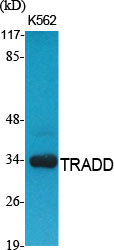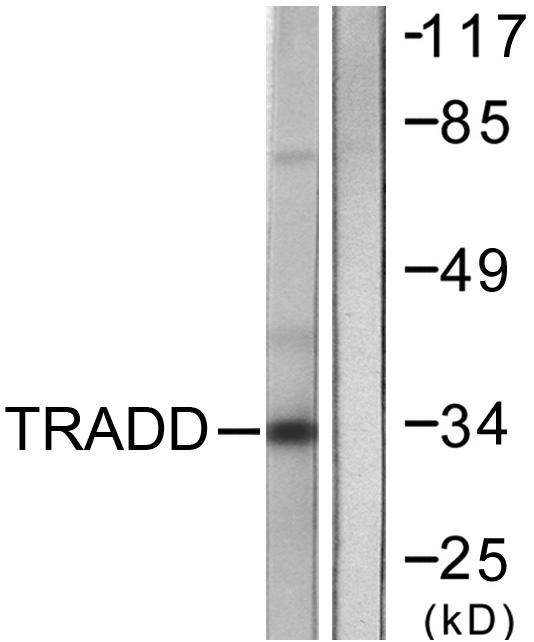TRADD Polyclonal Antibody
- Catalog No.:YT4716
- Applications:WB;IHC;IF;ELISA
- Reactivity:Human;Mouse;Monkey
- Target:
- TRADD
- Fields:
- >>MAPK signaling pathway;>>NF-kappa B signaling pathway;>>Sphingolipid signaling pathway;>>Apoptosis;>>Necroptosis;>>RIG-I-like receptor signaling pathway;>>IL-17 signaling pathway;>>TNF signaling pathway;>>Adipocytokine signaling pathway;>>Alcoholic liver disease;>>Pathogenic Escherichia coli infection;>>Shigellosis;>>Salmonella infection;>>Tuberculosis;>>Hepatitis C;>>Measles;>>Human cytomegalovirus infection;>>Influenza A;>>Human papillomavirus infection;>>Kaposi sarcoma-associated herpesvirus infection;>>Herpes simplex virus 1 infection;>>Epstein-Barr virus infection;>>Human immunodeficiency virus 1 infection;>>Viral carcinogenesis
- Gene Name:
- TRADD
- Protein Name:
- Tumor necrosis factor receptor type 1-associated DEATH domain protein
- Human Gene Id:
- 8717
- Human Swiss Prot No:
- Q15628
- Mouse Gene Id:
- 71609
- Mouse Swiss Prot No:
- Q3U0V2
- Immunogen:
- The antiserum was produced against synthesized peptide derived from human TRADD. AA range:251-300
- Specificity:
- TRADD Polyclonal Antibody detects endogenous levels of TRADD protein.
- Formulation:
- Liquid in PBS containing 50% glycerol, 0.5% BSA and 0.02% sodium azide.
- Source:
- Polyclonal, Rabbit,IgG
- Dilution:
- WB 1:500 - 1:2000. IHC 1:100 - 1:300. ELISA: 1:10000.. IF 1:50-200
- Purification:
- The antibody was affinity-purified from rabbit antiserum by affinity-chromatography using epitope-specific immunogen.
- Concentration:
- 1 mg/ml
- Storage Stability:
- -15°C to -25°C/1 year(Do not lower than -25°C)
- Other Name:
- TRADD;Tumor necrosis factor receptor type 1-associated DEATH domain protein;TNFR1-associated DEATH domain protein;TNFRSF1A-associated via death domain
- Observed Band(KD):
- 34kD
- Background:
- The protein encoded by this gene is a death domain containing adaptor molecule that interacts with TNFRSF1A/TNFR1 and mediates programmed cell death signaling and NF-kappaB activation. This protein binds adaptor protein TRAF2, reduces the recruitment of inhibitor-of-apoptosis proteins (IAPs) by TRAF2, and thus suppresses TRAF2 mediated apoptosis. This protein can also interact with receptor TNFRSF6/FAS and adaptor protein FADD/MORT1, and is involved in the Fas-induced cell death pathway. [provided by RefSeq, Jul 2008],
- Function:
- domain:Requires the intact DEATH domain to associate with TNFRSF1A/TNFR1.,function:Adapter molecule for TNFRSF1A/TNFR1 that specifically associates with the cytoplasmic domain of activated TNFRSF1A/TNFR1 mediating its interaction with FADD. Overexpression of TRADD leads to two major TNF-induced responses, apoptosis and activation of NF-kappa-B.,similarity:Contains 1 death domain.,subunit:Heterodimer with TNFRSF1A/TNFR1. Interacts with DAB2IP, FADD, HIPK2, KRT14, KRT16, KRT17, KRT18, RIPK1, SQSTM1, TRAF1, TRAF2 and TRPC4AP.,tissue specificity:Found in all examined tissues.,
- Subcellular Location:
- Nucleus . Cytoplasm . Cytoplasm, cytoskeleton . Shuttles between the cytoplasm and the nucleus. .
- Expression:
- Found in all examined tissues.
- June 19-2018
- WESTERN IMMUNOBLOTTING PROTOCOL
- June 19-2018
- IMMUNOHISTOCHEMISTRY-PARAFFIN PROTOCOL
- June 19-2018
- IMMUNOFLUORESCENCE PROTOCOL
- September 08-2020
- FLOW-CYTOMEYRT-PROTOCOL
- May 20-2022
- Cell-Based ELISA│解您多样本WB检测之困扰
- July 13-2018
- CELL-BASED-ELISA-PROTOCOL-FOR-ACETYL-PROTEIN
- July 13-2018
- CELL-BASED-ELISA-PROTOCOL-FOR-PHOSPHO-PROTEIN
- July 13-2018
- Antibody-FAQs
- Products Images

- Western Blot analysis of various cells using TRADD Polyclonal Antibody. Secondary antibody(catalog#:RS0002) was diluted at 1:20000
.jpg)
- Western Blot analysis of COS7 cells using TRADD Polyclonal Antibody. Secondary antibody(catalog#:RS0002) was diluted at 1:20000

- Immunohistochemistry analysis of paraffin-embedded human breast carcinoma tissue, using TRADD Antibody. The picture on the right is blocked with the synthesized peptide.

- Western blot analysis of lysates from COS7 cells, using TRADD Antibody. The lane on the right is blocked with the synthesized peptide.



